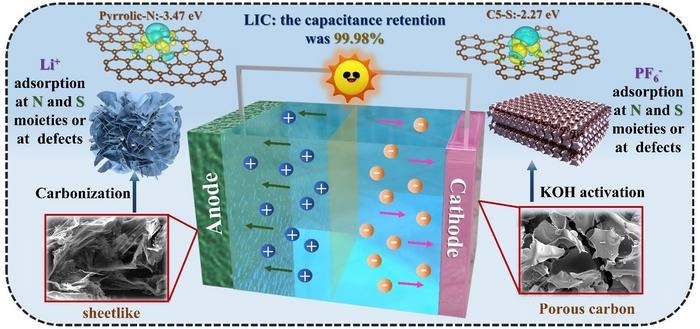Lithium-ion batteries (LIBs) and supercapacitors have long dominated the portable and electric energy storage industry, outperforming other energy storage devices in terms of their capacity to deliver more energy and power. However, there is an increasing need for a device that can effectively provide high power and high energy over a large number of cycles in important applications like electric vehicles.

A strategy for the commercial large-scale production of heteroatom-doped porous carbon materials was provided. Image Credit: X. Guo et al.
Researchers are looking at alternative technologies for energy storage devices since meeting these strict criteria poses new difficulties for existing technologies.
A possible approach is to adapt the structurally stable high-conductive hard carbon anode and pair it with an activated carbon cathode to produce a dual-carbon LIC (lithium-ion capacitor). In this study, sheet-like hard carbon was made using a one-pot in-situ expansion and heteroatom doping technique, and activated carbon was made using activation procedures.
However, ion kinetics mismatch between cathode and anode can lead to unsatisfied cycling lifetime and anode degradation. We used a special method to create two types of carbon materials: sheet-like hard carbon and activated carbon.
Yingxiong Wang, Study Corresponding Author, College of Chemistry, Taiyuan University of Technology
Ammonium persulfate was utilized by Wang and his coworkers to expand and alter the hard carbon, improving its suitability for use in batteries. The FRNS-HC and FRNS-AC carbon materials were created from furfural residues, which are byproducts of a natural chemical. Then they were examined in LIBs.
Wang added, “The results were impressive—when FRNS-HC was used as the negative part of the battery, it could store 374 mAh g–1 at low power level, and 123.1 mAh g–1 at a higher power level. When combined with a special porous carbon material as the positive part of the battery, the whole battery showed a high specific energy of 147.67 Wh kg–1, with a power output of about 199.93 W kg–1.”
Notably, the battery had a very long lifespan and performed almost perfectly even after 1,000 charges and discharges. In the KeAi journal Green Energy & Environment, the team reported their results.
Wang concluded, “We recommend the use of biomass-based raw materials as carbon precursors, along with efficient and eco-friendly synthesis techniques. This study offers a promising approach to create heteroatom-doped porous carbon from biomass waste, and it holds great potential for advancing high-energy-density devices.”
Journal Reference
Guo, X., et al. (2023) Furfural residues derived nitrogen-sulfur co-doped sheet-like carbon: An excellent electrode for dual carbon lithium-ion capacitors. Green Energy & Environment. doi:10.1016/j.gee.2023.05.007.